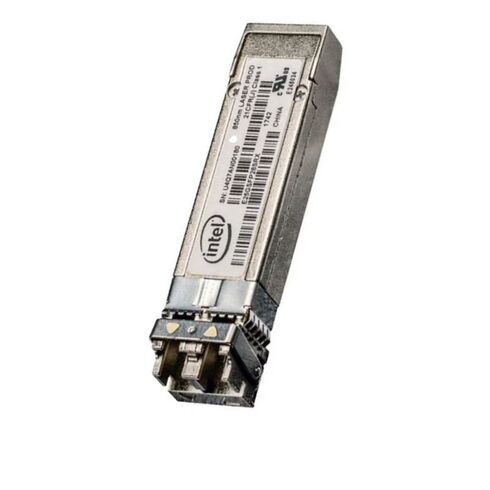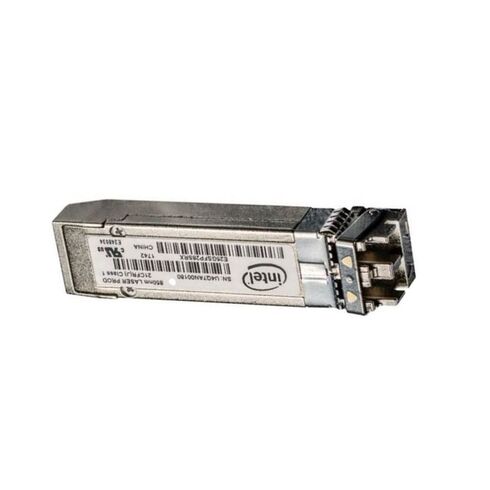LTF8505-BC-IN1 Intel 25GBPS SFP28 Short Range Transceiver Module
- — Free Ground Shipping
- — Min. 6-month Replacement Warranty
- — Genuine/Authentic Products
- — Easy Return and Exchange
- — Different Payment Methods
- — Best Price
- — We Guarantee Price Matching
- — Tax-Exempt Facilities
- — 24/7 Live Chat, Phone Support
- — Visa, MasterCard, Discover, and Amex
- — JCB, Diners Club, UnionPay
- — PayPal, ACH/Bank Transfer (11% Off)
- — Apple Pay, Amazon Pay, Google Pay
- — Buy Now, Pay Later - Affirm, Afterpay
- — GOV/EDU/Institutions PO's Accepted
- — Invoices
- — Deliver Anywhere
- — Express Delivery in the USA and Worldwide
- — Ship to -APO -FPO
- — For USA - Free Ground Shipping
- — Worldwide - from $30
Overview of INTEL LTF8505-BC-IN1 Ethernet SFP28 Optic
Key Features
- Supports 25GBASE-SR for high-speed data transmission.
- Ideal for optical fiber networks with 10 Gigabit Ethernet compatibility.
- Designed for efficient, reliable data networking over long distances.
- Optimized for high-performance applications in data centers and optical networks.
Technical Specifications
Data Rate and Connectivity
- 25GBASE-SR standard for superior data speeds.
- Compatible with high-speed Ethernet network infrastructure.
Physical Layer and Network Support
- Supports Optical Fiber for seamless long-distance connectivity.
- Designed for 10 Gigabit Ethernet networks, ensuring rapid data transfer.
Applications and Usage
Data Centers and Enterprise Networks
- Perfect for enterprise-grade optical network environments.
- Boosts the efficiency of data center operations with faster transmission rates.
Optical Networks
- Supports optical network configurations requiring 25GBASE-SR connectivity.
- Enables high-speed data routing through optical fiber links.
Compatibility
Broad Network Support
- Works seamlessly with a variety of network equipment, including switches and routers.
- Ensures excellent interoperability with multiple data center and networking solutions.
Performance and Efficiency
High-Speed Data Transmission
- Delivering up to 25G of data throughput for optimized performance.
- Low latency and minimal packet loss for consistent, uninterrupted network traffic.
Energy-Efficient Design
- Engineered to minimize power consumption without compromising performance.
- Suitable for environments focused on sustainability and energy savings.
The Intel LTF8505-BC-IN1
- Industry-leading performance with cutting-edge 25G optical technology.
- Versatile usage in both enterprise networking and optical fiber installations.
- Reliable, durable design for demanding network environments.
Intel LTF8505-BC-IN1 Ethernet SFP28 Optic - Key Features
The INTEL LTF8505-BC-IN1 Ethernet SFP28 Optic module offers exceptional performance for high-speed data networking. This optic module is designed for seamless integration in optical networks, providing reliable and efficient data transmission.
Advanced Connectivity for Optical Networks
Designed to meet the evolving needs of modern data centers and enterprise networks, this SFP28 optic module supports cutting-edge 25GBASE-SR technology. It ensures smooth and uninterrupted data flow over optical fiber, offering superior bandwidth and reduced latency.
Reliable Performance with 25GBASE-SR
With a focus on efficiency and speed, the LTF8505-BC-IN1 supports 25GBASE-SR, making it ideal for high-bandwidth applications. Whether you're optimizing your data center or upgrading network infrastructure, this module provides exceptional reliability in all conditions.
Compatibility and Integration
- Compatible with a wide range of 25GBASE-SR networks
- Supports 10 Gigabit Ethernet speeds, ensuring future-proof scalability
- Seamless integration with standard optical fiber infrastructure
Key Benefits of INTEL LTF8505-BC-IN1
- High-Performance Data Transmission: The module delivers consistent, high-speed data transfer, enhancing network efficiency.
- Cost-Effective Solution: Reduce the need for expensive upgrades by leveraging the LTF8505-BC-IN1’s advanced features at a competitive price point.
- Durability and Longevity: Designed with durability in mind, this optic module offers reliable long-term performance.
Optimized for Data Networking
This module is specifically engineered for optical network environments that require high data throughput. Whether you're working with 10 Gigabit Ethernet networks or deploying 25GBASE-SR connections, it ensures optimal performance across various network topologies.
Technical Specifications
- Speed: 25GBASE-SR for efficient data handling
- Interface: SFP28
- Compatibility: Compatible with optical fiber networks
- Applications: Ideal for data centers, enterprise networks, and telecommunications
Versatile Use Cases
The INTEL LTF8505-BC-IN1 module is perfect for a variety of environments, including:
- High-traffic data centers
- Enterprise-grade optical networking
- Telecommunication applications
Future-Proofing Your Network
As data transmission speeds continue to rise, the INTEL LTF8505-BC-IN1 ensures that your infrastructure can scale effectively. By supporting 25GBASE-SR, you are prepared for the demands of future network upgrades, giving you a competitive edge in performance.
Data Rate
The Intel LTF8505-BC-IN1 SFP28 Transceiver Module is designed to provide users with a high-speed data rate of 25GBPS. This feature is of utmost importance in today's fast-paced and data-driven world. In this section, we will explore the benefits and importance of the 25GBPS data rate in detail.
Enhanced Data Transmission
With a data rate of 25GBPS, this transceiver module ensures enhanced data transmission capabilities. Whether you are transferring large files, streaming high-definition videos, or working with bandwidth-intensive applications, the high-speed data rate enables seamless and quick data transfer. This means less waiting time and improved productivity for users.
Improved Network Performance
The 25GBPS data rate of the Intel LTF8505-BC-IN1 SFP28 Transceiver Module significantly improves overall network performance. It allows for faster communication between devices connected to the network, resulting in reduced latency and increased efficiency. This is especially crucial for businesses that rely on a robust and reliable network infrastructure to support their operations.
Smooth Video Streaming
For media-intensive industries such as broadcasting or video production, the 25GBPS data rate ensures smooth video streaming without any buffering or lag. Whether you are live streaming an event or editing high-resolution videos, this module provides the necessary bandwidth to handle the demanding requirements of such tasks.
Accelerated Data Backup and Recovery
Data backup and recovery processes are essential for maintaining business continuity and safeguarding critical information. With a 25GBPS data rate, the Intel LTF8505-BC-IN1 SFP28 Transceiver Module allows for faster and more efficient backup and recovery operations. This not only saves valuable time but also reduces the risk of data loss during critical moments.
Efficient Virtualization
In virtualized environments where multiple virtual machines are running simultaneously, the 25GBPS data rate of this transceiver module ensures smooth and efficient communication between the virtualized instances. It enables seamless migration of virtual machines, improves overall system performance, and enhances user experience.
Future-Proof Investment
Investing in a transceiver module with a high data rate like 25GBPS ensures that your network infrastructure is ready to handle future technological advancements. As technology continues to evolve, the demand for higher data speeds will only increase. By choosing the Intel LTF8505-BC-IN1 SFP28 Transceiver Module, you are future-proofing your network and avoiding the need for frequent upgrades.
Reach
The reach of a transceiver module refers to the maximum distance over which it can transmit data effectively. In the case of the Intel LTF8505-BC-IN1 SFP28 Transceiver Module, it is designed for short-range applications. Let's delve into the benefits and importance of this specific reach feature.
Optimized for Short-Range Communication
The Intel LTF8505-BC-IN1 SFP28 Transceiver Module is optimized for short-range communication, making it ideal for deployments where devices are in close proximity to each other. Whether you are setting up a local area network (LAN), connecting devices within a data center, or establishing point-to-point connections, this module ensures reliable and efficient communication over short distances.
Cost-Effective Solution
One of the key advantages of short-range transceiver modules is their cost-effectiveness. They require less powerful optical components compared to long-range modules, resulting in lower manufacturing costs. This cost-saving advantage translates to more affordable pricing for users without compromising on performance.
Eliminates the Need for Additional Equipment
The short-range reach of the Intel LTF8505-BC-IN1 SFP28 Transceiver Module eliminates the need for additional equipment, such as signal boosters or repeaters, that would be necessary for long-range communication. This not only reduces the overall cost of the network setup but also simplifies the installation process and minimizes potential points of failure.
Improved Energy Efficiency
Short-range transceiver modules consume less power compared to their long-range counterparts. By utilizing the Intel LTF8505-BC-IN1 SFP28 Transceiver Module for short-range communication, you can significantly reduce energy consumption, leading to cost savings and environmentally-friendly operations.
Reduced Signal Degradation
Over long distances, optical signals tend to degrade due to various factors such as attenuation and dispersion. By utilizing a short-range transceiver module, such as the Intel LTF8505-BC-IN1 SFP28, you can minimize signal degradation and ensure reliable data transmission without compromising on quality.
Flexibility in Network Design
Short-range transceiver modules offer greater flexibility in network design. Due to their limited reach, they allow for more compact and efficient network architectures. This is particularly beneficial in environments where space is limited or when deploying networks with specific topology requirements.
In conclusion, the Intel LTF8505-BC-IN1 SFP28 Transceiver Module offers a high-speed data rate of 25GBPS, enabling enhanced data transmission, improved network performance, and seamless video streaming. Its short-range reach provides cost-effective solutions, eliminates the need for additional equipment, improves energy efficiency, reduces signal degradation, and allows for flexible network design. By considering these features and their benefits, users can make an informed decision when selecting a transceiver module that meets their specific requirements.











